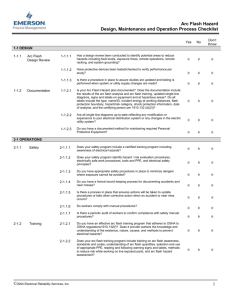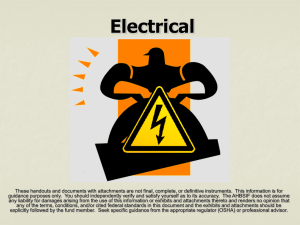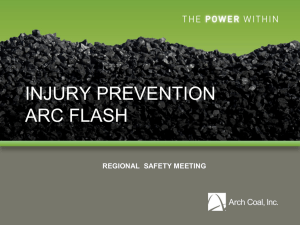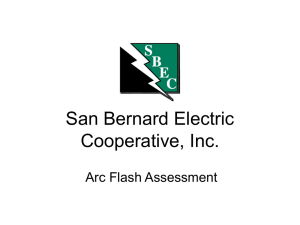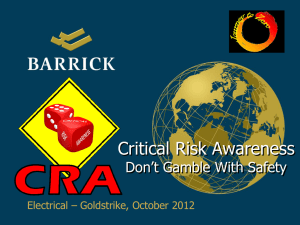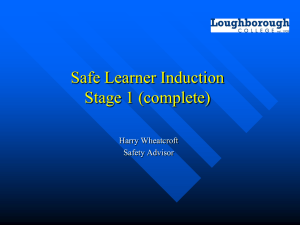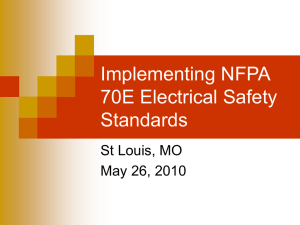PowerPoint "NFPA 70E - 2015 Electrical Safety
advertisement
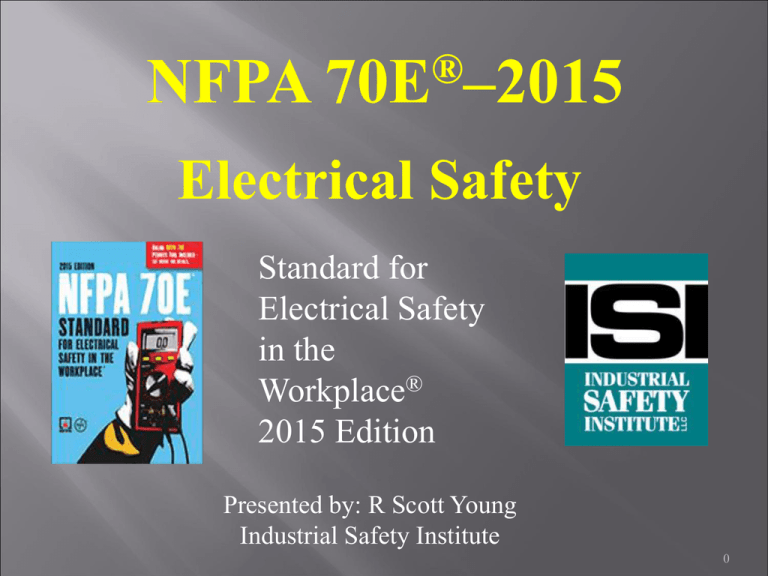
® NFPA 70E –2015 Electrical Safety Standard for Electrical Safety in the Workplace® 2015 Edition Presented by: R Scott Young Industrial Safety Institute 0 Topics covered today • Safety related work practices • Arc flash analysis and the Tables • Shock protection boundaries • Arc Flash Boundaries • Hazard risk categories • Appendix • Energized work permit 1 • Recognizing the hazards: – – – Exposure Electrical hazard Arc Flash hazard 2 3 6 • A Safe Work Area requires focus on the three most common factors for electrical accidents. According to OSHA these include: Equipment – Environment – Employee Work Practices – 7 • It is the Employer’s Responsibility to Provide: – – – Safe work – Equipment Safe work – Environment Safe work Practices • Documentation • Training 8 • It is the Employee’s responsibility to: – – – Use the Equipment Provided Pay attention to the Environment Use the Safe Work Practices (procedures) Provided by the Employer 9 Safe Electrical Work Practices Shall be Used • Avoid Shortcuts – Cord and Plug – Failure to de-energize – Unsafe tools – Horseplay – 10 90.2 Scope Covered. The standard addresses electrical safety related work practices safety-related maintenance requirements, and other administrative controls • Covered (examples) • Public and Private Premises (commercial & industrial) • Installations • Electric utilities for ALL facilities other than communications, metering, generation, control, transformation, transmission, or distribution Informational Note 11 90.3 Arrangement Chapter 2 applies to safety-related maintenance requirements for electrical equipment and installations in workplaces Informative Annex F, Risk Assessment Procedure 12 Chapter 1 Safety-Related Work Practices Article 100 Definitions 13 Definitions New definitions • • • • Hazard Hazardous Risk Risk assessment 14 Definitions • Boundary, Arc Flash • Calculated for 2nd degree burn–1.2 cal/cm2 Boundary, Limited Approach. An approach limit at a distance from an exposed energized electrical conductor or circuit part within which a shock hazard exists. 15 Definitions Boundary, Restricted Approach. An approach limit at a distance from an exposed energized electrical conductor or circuit part within which there is likelihood of electric shock, due to electrical arc-over combined with inadvertent movement, for personnel working in close proximity to the energized electrical conductor or circuit part. Note: Prohibited Approach has been removed 16 Chapter 1 Safety-Related Work Practices Article 110 General Requirements for Electrical SafetyRelated Work Practices 17 110.1 Electrical Safety Program. General. Employer shall document an overall electrical safety program appropriate to the risk associated with electrical hazards. implemented as part of the electrical safety and health program Maintenance. The electrical safety program shall include elements that consider condition of maintenance of electrical equipment and systems. 18 110.1 Electrical Safety Program. Awareness and Self-Discipline. The electrical safety program shall provide an awareness of the potential electrical hazards provide the required self discipline for all employees Instill safety principles and controls 19 110.1 Electrical Safety Program. Electrical Safety Program Procedures. An electrical safety program shall identify the procedures to be utilized before work is started by employees exposed to an electrical hazard 20 110.1 Electrical Safety Program. Risk Assessment Procedure. An electrical safety program shall include a risk assessment procedure that addresses employee exposure to electrical hazards. shall identify the process to be used by the employee before work is started to carry out the following: Identify hazards, Assess risks, Implement risk control according to a hierarchy of methods 21 110.1 Electrical Safety Program. Job Briefing. Before starting each job Briefing shall cover hazards associated with the job work procedures involved special precautions energy source controls PPE requirements the information on the energized electrical work permit, if required Additional job briefings shall be held if changes occur during the course of the work. 22 110.2 Training Requirements Type of Training On the Job / Classroom or both Emergency Response training Contact Release First Aid, Emergency response and Resuscitation Trained in First Aid, Cardiopulmonary Resuscitation(CPR), Automatic External Defibrillator (AED) Annual employer certification and documentation of training required 23 110.2 Training Requirements Employee Training. Qualified Person (cont.) Skills to: Make decisions for job planning and personal protective equipment (PPE) Perform the job safety planning, Identify electrical hazards, Assess the associated rise Select the appropriate risk control methods from the hierarchy of controls identified in 110.1(G), including personal protective equipment 24 110.2 Training Requirements Unqualified Person trained for their safety Retraining Retraining in safety-related work practices and applicable changes in this standard shall be performed at intervals not to exceed three years. 25 Chapter 1 Safety-Related Work Practices Article 120 Establishing an Electrically Safe Work Condition 26 120.2 – Application of Lockout/Tagout Principles of Lockout/Tagout Execution Retraining Retraining shall be performed: When procedures are revised At intervals not to exceed 3 years Training Documentation. Employer shall document employee training shall be made when employee demonstrates proficiency shall contain the content of the training, employee’s name, dates of training 27 Chapter 1 Safety-Related Work Practices Article 130 Work Involving Electrical Hazards 28 130.2 Electrically Safe Working Conditions Energized Work Normal Operations Shall be permitted where all of the following conditions are satisfied the equipment is properly installed is properly maintained doors are closed and secured All equipment covers are in place and secured no evidence of impending failure 29 130.2 Electrically Safe Working Conditions Energized Electrical Work Permit Energized electrical work permit shall be required in accordance with 130.2(A), under the following conditions: Work performed within the restricted approach boundary Employee working near equipment not exposed but an increased likelihood of injury from arc flash hazard exists 30 130.3 Working While Exposed to Electrical Hazards General Safety-related work practices shall – be used to safeguard employees electrical conductors and circuit parts – be determined before exposure to shock or arc flash hazard (using risk assessment) – ONLY qualified persons permitted to work on energized electrical conductors and circuit parts – put in electrically safe work condition 31 130.4 Approach Boundaries to Electrical Circuit parts or Conductors for Shock Protection Shock Risk Assessment. A shock risk assessment shall be used to determine the voltage to which personnel will be exposed Boundary requirements Necessary PPE 32 130.4 Approach Boundaries to Electrical Circuit parts or Conductors for Shock Protection Shock Protection Boundaries Limited Approach Boundary Unless permitted by 130.4(C)(3) Restricted Approach Boundary Tables 130.4(D)(a) & (b) 33 130.5 Arc Flash Risk Assessment Documentation Documentation required on all arc flash risk assessment. 34 130.5 Arc Flash Risk Assessment Arc Flash PPE – One of the following methods shall be used, either but not both: • Incident Energy Analysis Method • Engineering calculations (Annex D) • Arc Flash PPE Category Method – Table 130.7(C)(15) – Table 130.7(C)(16) 35 130.7 Personal and Other Protective Equipment Personal Protective Equipment (PPE) Selection of Personal Protective Equipment When Required for Various Tasks Incident energy analysis required by 130.5(C)(1) (AC equipment) When selected in lieu of the incident energy analysis of 130.5(C)(1), Table 130.7(C)(15)(A)(a) shall be used When arc flash PPE is required, Table 130.7(C)(15)(A)(b) shall be used to determine the arc flash PPE category See Informational Notes. (DC equipment) 36 130.7 Personal and Other Protective Equipment Personal Protective Equipment (PPE) An incident energy analysis shall be required in accordance with 130.5 for the following: •Tasks not listed in Table 130.7(C)(15)(A)(a) •Power systems with greater than the estimated maximum available short-circuit current •Power systems with longer than the maximum fault clearing times •Tasks with less than the minimum working distance 37 38 39 130.7 Personal and Other Protective Equipment Personal Protective Equipment (PPE) Arc flash PPE category identified from Table 130.7(C)(15)(A)(b) or Table 130.7(C)(15)(B), Table 130.7(C)(16) used to determine the required PPE for the task. Table 130.7(C)(16) lists PPE based on arc flash PPE categories 1 through 4. 40 41 130.7 Personal and Other Protective Equipment Alerting Techniques 1) Safety Signs and Tags Per ANSI Z535 2) Barricades –if arc flash boundary > limited approach, shall not be put closer than Arc flash boundary 3) Attendants 4) Look-Alike Equipment Standards for Other Protective Equipment – See Table 130.7(F) 42 Personal Protective Equipment Category specific Arc-Rated Clothing ARC 1 – minimum 4 cal/cm2 ARC 2 – minimum 8 cal/cm2 ARC 3 – minimum 25 cal/cm2 ARC 4 – minimum 40 cal/cm2 43 Chapter 3 Safety Requirements for Special Equipment 44 Batteries and Battery Rooms • Scope – Practical safeguarding of employees – Batteries that exceed 50 volts, nominal • • Definitions specific to article Safety procedures – General safety hazards – Battery risk Assessment – Electrolyte Hazards – Cell Flame Arresters & Cell Ventilation 45 Informative Annexes A–P 46 Questions? R. Scott Young Industrial Safety Institute WWW.IndustrialSafetyInstitute.com Ph 813.732.6445 Email: Rsyisi@gmail.com
